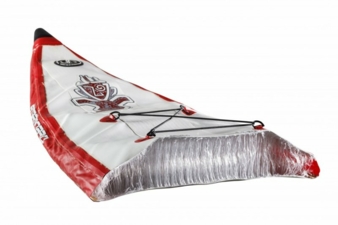14/05/2021 – Woven drop stitch fabric — auf Deutsch lesen
Vandewiele: Let the adventure begin
Vandewiele manufactures a double rapier weaving machine to produce drop stitch fabrics, called the VSi42 (Versatile Smart Innovator).
A drop stitch fabric, sometimes referred to as a double wall fabric, is a fabric, consisting out of 2 fabrics, interconnected by thousands of threads. It is the base fabric for many inflatable applications, like SUP paddle boards. Thanks to the connection threads the SUP maintains its shape when it is inflated to high pressure. Without drop stitch the board would bulge out in the middle like an over-inflated air mattress. Drop stitch allows to build inflatables with flat surface that can be inflated to rock-hard rigidity, resulting in a combination of hard-shell performance with the easy transportation and storage of an inflatable.
In the case of woven drop stitch fabrics, the two fabrics are woven on a single weaving machine, and the connection threads are inserted during weaving.
The advantages of the weaving process are:
The stability of the two fabrics, so that a thin coating or lamination is only required, resulting in a light product (compared to a warp knitted solution, requiring more heavy coating to obtain the stability of the two fabrics, resulting in a heavier product).
Flexibility in the distance between the fabrics. The weaving process allows changing of the distance between the fabrics, or changing the length of the connection threads during the weaving.
The weaving process can use a single weft insertion and inserting the weft of the top and bottom fabric one after the other, or having a double weft insertion system, inserting both wefts simultaneously. The single weft insertion system requires a discontinuous system, that, after weaving a certain length of ground fabrics, pulls the connecting yarns in between the two fabrics to a certain length.
The double weft insertion however, manufactures the whole construction in one step. On such a weaving machine, two shedding systems on top of each other are used, each with their own warp yarns, inserting fillings simultaneously in top and bottom shed by a double rapier system, and having also a third set of warp yarns making the connections between top and bottom fabric. The length of the connection yarns is determined by the distance between the top and bottom shed, more specific, at the line where the fabric is formed (at reed beat up).
There is also a technology available to multiply the length of the connection yarns by a number of times the physical distance between the fabrics during weaving. For this lancets are used (flatsteel wires keeping the two fabrics on a certain distance) and dummy wefts (that are not woven in to the ground fabric) are inserted around which the connection yarns are pulled. At a certain time during weaving this sandwich comes off the lancets, the dummy wefts become free and are removed. The connection yarns have a length of e.g. 3 or 5 or 7 times the physical distance between the fabrics during weaving.
There are different coating and or laminating processes available to make the drop stitch fabric airtight. Coating uses a liquid PVC paste that is brought on both sides of the fabric by impregnation. This offers the best result, the best adhesion and the flattest and lightest product. Laminating is the easier process and uses a pvc film that by pressure and heating is glued onto the fabrics and is typically used for low end applications. The lamination is also more used for the warp knitted drop stich. Because of lack of intrinsic stability of the knitted fabric a thick layer of PVC, if necessary even with a woven fabric in it, is applied, increasing the stability but increasing also the chance of delamination.
Besides PVC, most popular coatings are TPU and rubber, but more technical coatings are also available on the market for heavy duty and military applications (fire resistance, UV stability, abrasion resistance,...).
Applications are numerous:
Inflatable constructions:
to replace a hard shell: SUP paddle boards, kayaks (bottom and sides), floors for inflatable boats,…
floating properties: working platform to work around a ship, docks for jet ski, docks for fishing, rescuing rafts,...
with shock absorbing properties: air tracks for gymnastics, air matrasses (also for emergency uses because of very easy transportation and storage)
that require flatness: pop-up screens for outdoor cinemas (used for an audience up to 3,000 people or 250 cars)
of which sound isolation property is important: temporary noise protection walls for construction sites (reduction of 20 dB to 44 dB depending on frequency)
thermal isolation: temporary cooling cabins of which all walls are inflated double wall fabrics
that combines weight distribution and floating: cushions for rescuing people that fall through the ice
of which the inflation is used for lifting: lifting cushions for aircrafts, rescues,...
flooding protection: a custom-made set of cushions that is used to close doors and windows of a house during flooding
Other constructions:
reinforcement fabric for concrete tiles
tank linings
reinforcement for composites
ventilation layer in car seats
mattress protector to avoid bedsores
Vandewiele manufactures a double rapier weaving machine to produce drop stitch fabrics, called the VSi42 (Versatile Smart Innovator). It uses the same technology as the Velvet Smart Innovator VSi22, but has also a lancet system and a system for automatic removal of the dummy wefts in case a weave structure for multiplying the length of the connection yarns is used. The VSi42 is a high productive weaving machine, available in widths of 175, 215 and 345 cm, for a nominal fabric weaving width of 150 cm, 200 cm and 315 cm. The machine is equipped with a parallel reed motion, so that the reed is always straight during beat-up and guiding the rapiers perfectly during weft insertion. Among other things the machine is also designed to perform data exchange and prepared for the new “Industry 4.0” or “Factory of the Future” environment.


